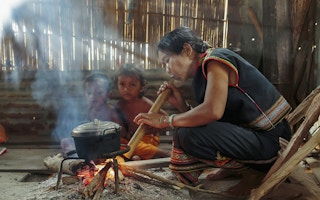Asian countries are making a vital contribution to achieving global sustainable energy goals, according to a new World Bank report. However, while the region performs strongly on ensuring electricity access for people and using more modern renewable energy, there is room for further improvement on energy efficiency and access to clean, smoke-free cooking, particularly for poor people. In total 1.1 billion people still have no access to adequate energy.
The report is part of a series of research that tracks the world’s progress toward the three goals of the Sustainable Energy for All (SE4All) initiative. This includes the aims of providing universal energy access, doubling the global rate of improvement in energy, efficiency and doubling the share of renewable energy by 2030.
Asia accounted for about 60 percent of the global progress on energy access and clean energy objectives during 2010-2012—according to the report titled “Progress Toward Sustainable Energy: Global Tracking Framework 2015”—contributing well beyond its share of global population and energy consumption. Asia’s performance on expanding modern renewable energy (from sources like solar, wind and geothermal) was particularly strong. Whereas globally, consumption of modern renewable energy grew by 4 percent per annum during 2010-2012, in Asia that growth was almost twice as fast at close to 8 percent.
Asia also moved rapidly to expand access to electricity for its citizens growing the population with electricity by 0.9 percent annually over the tracking period 2010-2012, well ahead of the global rate of 0.6 percent. While the global population with access to clean, modern cooking fuels actually fell during 2010-2012, Asia showed a modest improvement in access, but still far short of what is needed.
“
However, while the region performs strongly on ensuring electricity access for people and using more modern renewable energy, there is room for further improvement on energy efficiency and access to clean, smoke-free cooking, particularly for poor people.
But while the world avoided using as much energy in 2012 as Japan used the same year, the report says energy intensity must decline at least 50 percent faster to achieve the SE4All energy efficiency goal. Global consumption of modern renewable energy accelerated by 4 percent per year between 2010 and 2012, but must be closer to 8 percent—two times the current rate—to reach the SE4All renewable energy goal.
Asia’s progress on reducing the energy intensity of its economies with a compound annual growth rate of 1.3 percent annually—a commonly used measure of energy efficiency—lagged behind the global average of 1.7 percent. The report highlights some strong performances during the 2010-2012 tracking period including:
- India, Philippines and Bangladesh were the strongest performers on electricity access and added around 4 percentage points to electricity access rates.
- Vietnam and Indonesia were particularly strong on access to clean, modern cooking fuels, and added around 3-4 percentage points to their access rates.
- Japan and Indonesia stood out in reducing their energy intensity (commonly used as an indicator of energy efficiency) by a compound annual growth rate of around 5 percent.
- Australia and China increased their renewable energy shares by about 1 percentage point each.
On a global basis, the report found that 222 million people worldwide got access to electricity between 2010 and 2012, still leaving 1.1 billion people without access to energy. Meanwhile, 2.9 billion people are still using biomass fuels like wood and dung. Most of this population is in rural areas of South Asia, and eastern Asia. There is therefore a clear role for thinking about energy and access to energy as part of community investment programmes.
One of the challenges facing the private sector is to help enable energy access for all. This means expanding access to clean, reliable and affordable energy services for poor people. Critical here will be innovation to help provide more affordable and reliable energy products and services in low-income energy markets.
What will be important is partnerships between businesses and others stakeholders and cross-sector approaches to identify needs and solutions. Such partnerships will be particularly important drivers of progress toward universal access to energy.
Richard Welford is chairman, CSR Asia. This post is republished from the CSR Asia Weekly.











